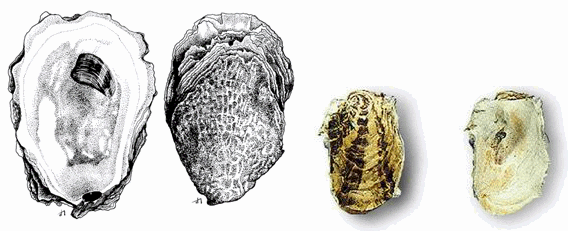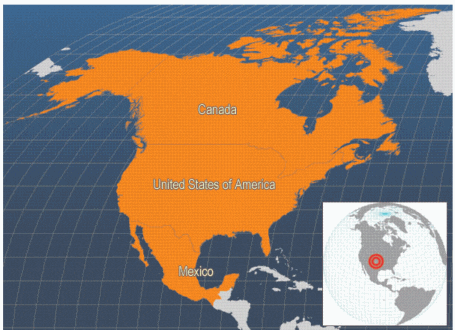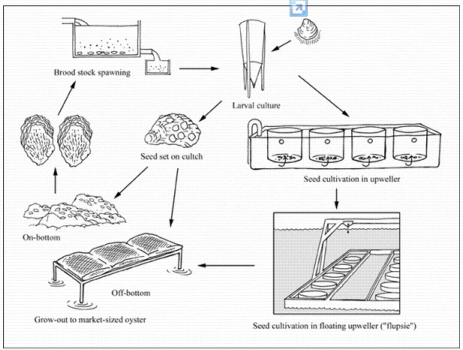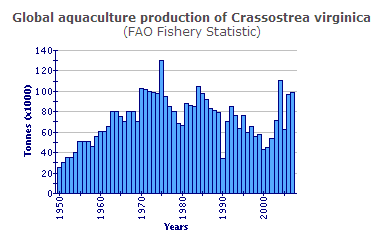Identity
Crassostrea virginica Gmelin, 1791 [Ostreidae]
FAO Names: En - American cupped oyster, Fr - Huître creuse américaine, Es - Ostión virgínico

Biological features
Shell solid, inequivalve left (lower) valve convex, right (upper) valve tending to be flat, though often bent sitting within the left; inequilateral, beaks and umbones not prominent, tending to be broadly oval in outline but often distorted. Ligament internal, attached to a central triangular pit, with lateral extensions. Sculpture of concentric ridges and lines with a few irregular radiating ribs on the left valve which do not normally meet or indent the margin. Hinge line without teeth in the adult. Shell margins smooth. Colour white, dirty white or brown, sometimes with dark purple markings. Periostracum thin, dark brown; interior of shell white; adductor muscle scar near the posterior margin, a deep purple or red-brown.
View SIDP Species fact sheet
Profile
Historical background
Oysters, predominantly American cupped oysters, are the most economically important group of molluscs in the US capture fisheries, with landings of ~109 000 tonnes in 2002. They are much less important in Canada, with landings of ~2 400 tonnes in 2002. Harvests are a fraction of those of a century ago because of over-fishing, habitat destruction, pollution, and disease.
In eastern North America, culture efforts began a century ago to rehabilitate over-harvested oyster grounds and improve harvests. The simplest culture method (still practiced today) involved spreading oyster shells (cultch) over depleted oyster bottom where the remnant adults were expected to produce larvae that would settle on the cultch as spat. Cultch was (and still is) obtained from shucked oyster shell produced by oyster-processing facilities or by dredging "fossil" shells from beneath estuarine sediments. If settlement on the shelled grounds was successful and if the habitat was suitable, the spat were left to grow to market size. If growth was slow, the spat were dredged and removed to a better growing habitat when they were large enough (seed oysters) to be dredged with minimal shell damage. Natural seed growing on sub-optimal, non-shelled grounds was also harvested and moved to better growing grounds. From the 19th Century until today, government agencies have used these techniques to rehabilitate public grounds, while private enterprises have used leased grounds where this is permitted. Most oyster culture on the North American Atlantic coast uses the American cupped oyster. There is some culture of the European oyster Ostrea edulis.
In western North American in the late 1800s, pollution and overfishing depleted the beds of the native Olympia oyster Ostrea conchaphila, so Crassostrea virginica was imported from the east coast. Western summer temperatures were too cool for dependable reproduction to occur in C. virginica, so small seed oysters (~2.5 cm) were imported annually and held in coastal bays to reach commercial size. Eventually the bays became polluted, so west coast governments and entrepreneurs turned to the Pacific oyster Crassostrea gigas as the basis for a thriving aquaculture industry after 1929. Today, there is limited culture of the American cupped, European, and Olympia oysters on the west coast.
Over time, North America culturists learned how to condition oysters for spawning (broodstock). They developed algal foods and nutritional supplements for maximum larval growth, learned how to increase larval survival and enhance settlement in hatcheries and to protect spat while they grow large enough to be safe from many predators, and optimised placing spat and seed oysters on natural beds.
Main producer countries
The American cupped oyster ranges from Canada's Gulf of St. Lawrence to the Gulf of Mexico, the Caribbean, and the coasts of Brazil and Argentina. It has been introduced to British Columbia, Canada; the west coast of the United States; Hawaii; Australia; Japan; and the United Kingdom, but has not established self-sustaining commercial populations. It is cultured throughout its eastern North American range and in places on the North American west coast, and almost nowhere else.

Habitat and biology
The American cupped oyster thrives in estuaries, but also lives in marine coastal environments. It discharges gametes into the water column in response to a variety of stimuli, including warmer temperatures, pheromones, and the presence of appropriate phytoplankton. Fertilised eggs develop into trochophore larvae that depend on their internal yolk supply for energy. After about 24 hours, the trochophore develops into a shelled veliger larva that uses a ciliated organ (velum) to capture food and to swim. After two or three weeks, depending on food and temperature conditions, the veliger develops an eyespot and a larval foot (it is now called an eyed larva or pediveliger) with which it explores potential settlement substrates. Upon being stimulated to settle, it cements its left valve to the substrate and metamorphoses into an oyster spat by discarding its velum, reabsorbing its foot, and enlarging its gills.
Production
Production cycle

Production systems
Oyster culture is affected by factors like temperature and salinity, water circulation, the presence and condition of substrate, productivity of appropriate algal food, presence of predators and disease, and protection from ice or storms that might damage culture facilities. Hatcheries allow the culturist to control many of these factors, thus enhancing larval and spat production. Whether oyster cultivation begins in a hatchery or in nature, eventually small oysters are used in either on-bottom or off-bottom (suspended) culture.
Seed supply
North American hatcheries generally use mass culture of algae in tall, clear fibreglass tubes, in very large vats, or in clear, flexible plastic bags from which algae are harvested continuously. The most common cultured algae are the diatoms Chaetoceros calcitrans and Thalassiosira pseudonana (clone 3H Hasle et Heimdal), and a flagellate Isochrysis galbana Tahitian strain (T-iso). Because of the cost of raising enough algae to feed millions of larvae and spat, hatchery-reared oysters are moved into nature as quickly as possible.
Non-ripe adults can be held at low temperatures (usually <20 °C) and fed either natural algae under flow-through conditions or cultured algae in limited flow conditions until they become ready to spawn, usually months before they would in nature. Alternatively, ripe adults can be harvested in nature and brought to the hatchery to be spawned, a process that ends when the spawning season ends in nature.
To initiate spawning, ripe adults are held in containers and heat-shocked with warm water (up to ~30 °C), perhaps with gametes stripped from a ripe adult being added to the containers. Spawning oysters are segregated by sex into smaller containers. After 20 or 30 minutes, the spawned oysters are removed from these containers and the sperm and eggs are washed separately through fine screens that retain debris and oyster tissue expelled during spawning. A small amount of sperm from several males is then mixed with the eggs and fertilisation is monitored microscopically to ensure it has been successful. The fertilised eggs are placed in large aerated tanks to develop into trochophore larvae and beyond.
As the larvae grow they are washed every few days through a series of graded sieves that capture different size classes. The larger, faster-growing larvae may be selected; alternatively all larvae may be kept. Those that are kept are placed into new water and fed until they become pediveligers. Subsequently, pediveligers are placed in special setting tanks containing either microcultch (finely ground [~0.025 mm] oyster shell) on which they settle as single cultchless oysters or oyster shell cultch in mesh bags or other containerised systems (these spat usually grow in aggregations). Microcultch systems run water gently downward to keep the larvae within the containers (downwellers) until they settle. Thereafter, the water is reversed to flow upward (upwellers) vigorously through the spat to deliver food, remove wastes, and enhance growth.
Pediveligers may be screened from their culture tanks and held in damp paper or cloth in the refrigerator for a few days in a process called "remote setting". The pediveligers are then shipped in a "cool box" by express transport to culturists who place the larvae in tanks to settle on microcultch or cultch. Thus one hatchery can supply many culturists, none of whom needs to invest in their own hatchery.
Ongrowing techniques
Eventually the culturist must place seed oysters in nature because of the cost of artificially feeding them. Seed oysters, whether produced in hatcheries or harvested in the wild, can be cultured on or off the bottom.
On-bottom culture
As described earlier, the simplest on-bottom culture method does not involve hatcheries. Rather, it depends on transplanting seed oysters to suitable bottom to grow to market size. If the oysters are harvested from public grounds, costs can be low because harvesting fees are usually minimal or non-existent and because the harvest gear is usually inexpensive tongs or dredges. An important expense is the cost of preparing the bottom to receive the seed, perhaps by adding shell or other substrate to stabilise it. Costs increase further if transportation distances are great or if the oysters have to be purchased, either from a commercial harvester or from a hatchery. It may also be costly if environmental conditions inhibit growth, if predation pressure is high, or if mortality from diseases is a problem.
A more complex bottom culture method, bag-and-longline culture, places cultchless seed in mesh bags attached to an anchored line and held intertidally on a hard bottom. Intertidal exposure of the oysters to the air helps protect against predators and fouling organisms that are inhibited or killed by such exposure (fouling organisms compete with the oysters for food and oxygen and add to the weight of the bags, thereby increasing labour or monetary costs of handling the bags).
Off-bottom culture
Bottom culture suffers from the fact that bottom currents tend to be slow, thereby hindering food delivery and waste removal, as well as enhancing sediment deposition onto the oysters, thus interfering with their feeding. Further, many oyster predators live on the bottom. Off-bottom culture ameliorates the negative aspects of bottom culture and makes use of the complete water column, although it is more expensive because it is more labour and technology intensive. Nevertheless, under certain conditions the expense can be justified because of the benefits. For example, in New Brunswick, Canada, with relatively cold ambient water temperatures and a short growing season, a young oyster can reach a commercial size after about 3 years in off-bottom culture compared with up to 8 years in bottom culture.
A number of off-bottom techniques are available, with cultchless spat or seed preferred because cultch is heavy, occupies space, and has high labour and energy costs of handling. Spat may be grown in trays until their shells are strong enough to avoid damage when handled. Bag-and-longline culture holds mesh bags of spat or seed suspended in the water column while attached to an anchored line whereas rack-and-bag culture has the bags fastened to racks that sit above the bottom. Rack culture strings spat-bearing oyster shells on lines, with the shells separated by inert spacers and the lines hanging from racks whereas stake culture impales spat-bearing oyster shells separated by spacers on a stake driven into the substrate. Lantern nets hung from floats are cylindrical containers fashioned from nylon netting and divided into sections in which the oysters are placed. In Stanway tube culture, cultchless oysters in mesh tubes are rotated around an axle by currents.
Harvesting techniques
Cultivation of the American cupped oyster is generally labour-intensive, although mechanical systems are coming into play. For on-bottom culture, oysters can be placed on and harvested by hand from intertidal habitat; hand-operated tongs are used on subtidal beds. Dredges pulled by a vessel are also used on subtidal habitat. Where oysters are grown in bags (on- or off-bottom), in tubes and lantern nets, or on shell-strings, mechanical devices can be used to lift the containers out of the water and onto a vessel for sorting, cleaning, and harvest.
Handling and processing
Oysters harvested for sale are washed or scrubbed clean, then shipped whole to processors. These firms remove (shuck) the soft body (usually done by hand, although mechanical aids are being developed) for added-value processing (e.g. canning, freezing, breading). They may also sell the whole animal to restaurants for the half-shell trade, in which the flatter shell is removed and the soft body is served in the remaining cupped shell (see also Market and trade, below).
Production costs
Recently, it was estimated that production costs for intensive culture (2.5 million seed oysters/hectares) in Florida totalled USD 75 000/ha, with seed, equipment, and labour costing USD 25 000 each. In this situation, oyster survival needs to be 30 per cent to achieve break-even if oysters sell for USD 0.10 each.
Diseases and control measures
| DISEASE | AGENT | TYPE | SYNDROME | MEASURES |
|---|---|---|---|---|
| Malpeque Bay Disease | Unknown | Unknown | Mantle regression; gaping; oedema & cream/yellow coloured abscesses up to 1 cm in diameter in body wall; yellow-green scars may also appear on inner surface of shell adjacent to lesions in the soft tissues | Do not introduce oysters from areas which have been affected, historically, by Malpeque disease |
| Dermo Disease; Proliferative Disease; Perkinsosis | Perkinsus marinus | Protozoan parasite | Pale appearance of digestive gland; reduction in condition index; severe emaciation; gaping; shrinkage of mantle away from outer edge of shell; retarded growth; occasionally presence of pus-like pockets; proliferation of parasite causes systemic disruption of connective tissue & epithelial cells; syndrome correlated with warm summer water temperatures (>15-20 °C), when pathogenicity & associated mortalities are highest | No known cure; improved control over transfers; improved management by reducing density & harvesting or moving oysters to low salinity areas (<9‰) before water temperatures increase to 15-20 °C; filter water for hatcheries to 1 µm & treat with ultraviolet light (30 000 µW s ?¹ cm?² UV irradiation) |
| Juvenile Oyster Disease (JOD) | Unknown | Unknown | Reduced tissue & shell growth; fragile & uneven shell margins; cupping of the left valve; reduced condition index; mantle retraction & abnormal proteinaceous material (conchiolin) deposits around periphery of mantle on inner shell surface: dying oysters may also display unequal shell growth, with the left valve outgrowing the right valve, & tissue emaciation; can decimate cultured seed | No known preventative measures; can be ameliorated by growing seed past 30 mm as quickly as possible by spawning adults earlier in season, increasing water flow over young spat, & providing food & temperatures that enhance growth; alternatively, spawning adults late in the season also helps; mortality can be reduced or eliminated when oysters are maintained in 25 µm filtered water diluted with high salinity well water; reducing stocking densities within growing trays also improves survival |
| MSX (Multinucleate Sphere X) disease; Haplosporidiosis; Delaware Bay disease | Haplosporidium nelsoni. Its life cycle is unknown | Protozoan parasite | Thin and watery condition, with pale digestive diverticula. A gradual disruption of digestive tubule epithelia may occur, or acute infections may advance so swiftly that there are no clinical signs before death occurs. Mortalities in infected oysters may occur early in the spring, as may infection of new oyster hosts. Mortalities continue through the summer, peaking in August-September. | High mortalities occur rapidly at 18 to 20 ‰, so disease-free oysters should not be introduced to high-salinity habitat. The parasite cannot survive below 10 ‰ salinity, so infections can be rapidly eliminated by placing oysters in mean salinities of =10 ‰ and temperatures >20 °C. |
Statistics
Production statistics

It is difficult to determine the amount of cultured oysters produced in North America because most reporting jurisdictions do not distinguish between wild harvest and culture. However, on the Atlantic and Gulf of Mexico coasts, most of the harvest has been from public grounds. The Canadian wild fishery is estimated to account for 80 to 85 per cent of landed oysters in Prince Edward Island and 55 per cent in eastern New Brunswick (these provinces produce over 90 per cent of all oysters produced in eastern Canada). An effort has been made to estimate culture in the US over recent years (US Dept Commerce, Fisheries Statistics 2002). However, these estimates include values for the Pacific oyster, which have averaged 4 000 tonnes annually over the period. Subtracting this amount from the total estimates leaves about 4 000 tonnes for other oysters, predominantly the American cupped oyster. Total landings for American cupped oysters have averaged 12 000 tonnes over the same period, so we can conclude that aquaculture produces about one-third of all landings of this species in the US.
Market and trade
Oysters are marketed in the shell and are available in restaurants and bars alive on the half-shell (these are also available frozen). They are also marketed as shucked oysters (removed from their shell). The shucked meat is packaged in a diversity of containers and sold fresh or frozen. Value-added products include soups and chowders, as well as breaded, smoked, or sauced products.
Status and trends
Culture of the American cupped oyster in most regions of North America today depends greatly on nature. Hatcheries are expensive to build and maintain, although they are extensively used in the Long Island Sound region of the United States. Laws limiting the extraction of water from and returning it to waterbodies in some states affect hatcheries. Ship navigation takes legal precedence over moored aquaculture racks, longlines, etc. Mechanisation of culture systems in nature is underdeveloped. Disease is rampant in many areas, dissuading entrepreneurs from risking their capital. Nevertheless, many projects are underway in the public and private sectors to improve oyster culture, so the future is promising.
Main issues
The American cupped oyster industry has long been hampered by a lack of seed oysters and of oyster shell to serve as cultch. Historically, shucked shell was used to build roads or fill in marshes, or was used for chicken grit or agricultural lime. Whole oysters were and still are shipped to cities and towns far away, with the consequent loss of the shell from the harvest region. These actions depleted the supply of shucked shell that might have been replaced on the beds. "Fossil" shell is a finite resource that is running out. Shells of other bivalves sometimes serve as cultch if they are abundant and close enough to oyster grounds to be economical to transport. However, they are usually not as suitable as oyster shell.
Oysters remove particles from the water column, so they can consume and concentrate human pathogens (e.g. bacteria and viruses that cause hepatitis-a, gastroenteritis, etc.) as well as toxins from blooms of certain microscopic algae ("red tides") that can produce paralytic shellfish poisoning in humans. Toxic hydrocarbons, pesticides, radioisotopes, and heavy metals may also be concentrated and sicken humans. Such public health issues can depress the market for oysters. North American governments have established programmes to monitor shellfish growing areas for the presence of pathogens by use of indicator tests such as that for faecal coliform bacteria that may be associated with the presence of pathogens. In addition, the programmes provide a sanitation guide for operating, inspecting, and certifying shellfish shippers, processors, and depuration facilities, and for controlling interstate shipments of shellfish.
Until recently, east and Gulf coast North American oyster industries have not had long-term breeding programmes, thus hindering the domestication of oyster broodstock. A broodstock improvement programme is underway in some New England States. Several projects in the Mid-Atlantic States are focused on developing disease-resistant oysters.
The oyster fishery in Chesapeake Bay has become effectively non-existent. There is pressure from industry to introduce Crassostrea ariakensis from Asia to establish a new fishery. Some observers maintain that the American cupped oyster shows promise of developing resistance to at least one of its lethal diseases, so an introduced species is unnecessary. Others say such resistance is developing too slowly to save the declining industry. The lack of much information on the natural history and ecological requirements of the Asian species causes concern about unintended consequences that might follow from an introduction. It will take some time to determine the best course of action.
Responsible aquaculture practices
Coastal oyster culture has to conform to a variety of regulations governing navigation, water quality, and aesthetics. Culture structures should not impede navigation and high density culture within a relatively small space is avoided as it potentially deteriorates water quality and affects both the oysters and the ecosystem. Aesthetics is an issue because many riparian owners object to the sights and sounds associated with commercial shoreline structures and activities. In addition, on-land hatcheries may have unsightly mounds of oyster shell and equipment in the vicinity, and may extract and discharge large volumes of water from the adjacent water body, for which permits may be required. If non-native oyster species are involved, there will usually be stringent restraints to prevent any possible release of non-sterile animals into the environment to avoid inadvertent introductions. Studies of these matters are underway to anticipate and solve problems.
January 2010




